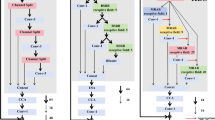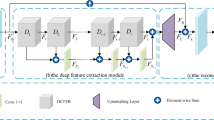Abstract
Super-resolution (SR) technology based on deep learning has achieved excellent results. However, too many convolution layers and parameters consume a very high computational cost and storage space when training the model, which dramatically limits the practical application. To solve this problem, this paper proposes a lightweight feature asymmetric distillation SR network (FADLSR). FADLSR constructs the feature extractor module through the stacked feature asymmetric distillation block (FADB). It extracts the low-resolution image features hierarchically and integrates them to obtain more representative features to improve the SR quality. In addition, we design a new focus block and add it to FADB to improve the quality of feature acquisition. We also introduce asymmetric convolution to strengthen the key features of the skeleton region. Detailed experiments show that our FADLSR has achieved excellent results in objective evaluation criteria and subjective visual effect on the test sets of Set5, Set14, B100, Urban100, and Manga109. The parameters of our model are roughly the same as those of the current state-of-the-art models. Moreover, in terms of model performance, FADLSR is 10–15% higher than the comparison algorithms.











Similar content being viewed by others
References
N. Ahn, B. Kang, K. Sohn, Fast accurate and lightweight super-resolution with cascading residual network, in Computer Vision—ECCV 2018, PTX, vol. 11214 (2018), pp. 256–272
M. Bevilacqua, A. Roumy, C. Guillemot, M.A. Morel, Low-complexity single-image super-resolution based on nonnegative neighbor embedding, in Proceedings of the British Machine Vision Conference, vol. 135 (2012), p. 1
Y. Cheng, Mean shift mode seeking and clustering. IEEE Trans. Pattern Anal. Mach. Intell. 17(8), 790–799 (1995)
T. Dai, J. Cai, Y. Zhang, S. Xia, L. Zhang, Second-order attention network for single image super-resolution, in 2019 IEEE/CVF Conference on Computer Vision and Pattern Recognition (2019), pp. 11057–11066
X. Ding, Y. Guo, G. Ding, J. Han, ACNet: strengthening the kernel skeletons for powerful CNN via asymmetric convolution blocks, in IEEE/CVF International Conference on Computer Vision (2019), pp. 1911–1920
C. Dong, C.C. Loy, K. He, X. Tang, Learning a Deep Convolutional Network for Image Super-Resolution, vol. 8692 (Springer, New York, 2014), pp.184–199
C. Dong, C.C. Loy, X. Tang, Accelerating the super-resolution convolutional neural network, in Computer Vision—ECCV, PT II, vol. 9906 (2016), pp. 391–407
J. Huang, A. Singh, N. Ahuja, Single image super-resolution from transformed self-exemplars, in 2015 IEEE Conference on Computer Vision and Pattern Recognition (2015), pp. 5197–5206
Z. Hui, X. Gao, X. Wang, Lightweight image super-resolution with feature enhancement residual network. Neurocomputing 404, 50–60 (2020)
Z. Hui, X. Gao, Y. Yang, X. Wang, Lightweight image super-resolution with information multi-distillation network, in Proceedings of the 27th ACM International Conference on Multimedia (2019), pp. 2024–2032
Z. Hui, X. Wang, X. Gao, Fast and accurate single image super-resolution via information distillation network, in IEEE/CVF Conference on Computer Vision and Pattern Recognition (2018), pp. 723–731
J. Kim, B. Kim, P.P. Roy, D. Jeong, Efficient facial expression recognition algorithm based on hierarchical deep neural network structure. IEEE Access 7, 41273–41285 (2019)
J. Kim, J.K. Lee, K.M Lee, Accurate image super-resolution using very deep convolutional networks, in Proceedings of the IEEE Conference on Computer Vision and Pattern Recognition, vol. 4 (2016), pp. 1646–1654
J. Kim, J.K. Lee, K.M. Lee, Deeply-recursive convolutional network for image super-resolution, IEEE Conference on Computer Vision and Pattern Recognition (2016), pp. 1637–1645
W. Lai, J. Huang, N. Ahuja, M. Yang, Deep Laplacian pyramid networks for fast and accurate super-resolution, in 30th IEEE Conference on Computer Vision and Pattern Recognition (2017), pp. 5835–5843
D. Liu, B. Wen, Y. Fan, C.C. Loy, T.S. Huang, Non-local recurrent network for image restoration. Adv. Neural. Inf. Process. Syst. 31, 31 (2018)
J. Liu, J. Tang, G. Wu, Residual feature distillation network for lightweight image super-resolution. arXiv preprint arXiv:2009.4155 (2020)
J. Liu, W. Zhang, Y. Tang, J. Tang, G. Wu, Residual feature aggregation network for image super-resolution, in IEEE/CVF Conference on Computer Vision and Pattern Recognition (2020), pp. 2356–2365
D. Martin, C. Fowlkes, D. Tal, J. Malik, A database of human segmented natural images and its application to evaluating segmentation algorithms and measuring ecological statistics, in IEEE (2001), pp. 416–423
Y. Matsui et al., Sketch-based manga retrieval using manga109 dataset. Multimed. Tools Appl. 76(20), 21811–21838 (2017)
B. Niu, A. Vedaldi et al., Single Image Super-Resolution Via a Holistic Attention Network (Springer, New York, 2020), pp.191–207
V. Pandey, K. Anand, A. Kalra, A. Gupta, P.P. Roy, B. Kim, Enhancing object detection in aerial images. Math. Biosci. Eng. 19(8), 7920–7932 (2022)
A. Sain, A.K. Bhunia, P.P. Roy, U. Pal, Multi-oriented text detection and verification in video frames and scene images. Neurocomputing 275, 1531–1549 (2018)
L. Sun, Z. Liu, X. Sun, L. Liu, R. Lan, X. Luo, Lightweight image super-resolution via weighted multi-scale residual network. IEEE/CAA J. Autom. Sin. 8(7), 1271–1280 (2021)
Y. Tai, J. Yang, X. Liu, Image super-resolution via deep recursive residual network, in 30th IEEE Conference on Computer Vision and Pattern Recognition (2017), pp. 2790–2798
Y. Tai, J. Yang, X. Liu, C. Xu, MemNet: a persistent memory network for image restoration, in IEEE International Conference on Computer Vision (2017), pp. 4549–4557
C. Tian et al., Lightweight image super-resolution with enhanced CNN. Knowl. Based Syst. 205, 106235 (2020)
R. Timofte, et al., NTIRE 2017 challenge on single image super-resolution: methods and results, in IEEE Conference on Computer Vision and Pattern Recognition Workshops (2017), pp. 1110–1121
J. Yang, J. Wright, T.S. Huang, Y. Ma, Image super-resolution via sparse representation. IEEE Trans. Image Process. 19(11), 2861–2873 (2010)
X. Yang, D. Liu, D. Zhou, S. Fei, Super-resolution reconstruction of face images based on pre-amplification non-negative restricted neighborhood embedding. Bull. Pol. Acad. Sci. Tech. Sci. 66, 6 (2018)
X. Yang, T. Xie, Y. Guo, D. Zhou, Remote sensing image super-resolution based on convolutional blind denoising adaptive dense connection. IET Image Proc. 15(11), 2508–2520 (2021)
K. Zhang, W. Zuo, L. Zhang, Learning a single convolutional super-resolution network for multiple degradations, IEEE/CVF Conference on Computer Vision and Pattern Recognition (2018), pp. 3262–3271
Y. Zhang, K. Li, K. Li, L. Wang, B. Zhong, Y. Fu, Image super-resolution using very deep residual channel attention networks, in Proceedings of the European Conference on Computer Vision (2018), pp. 286–301
Y. Zhang, K. Li, K. Li, B. Zhong, Y. Fu, Residual non-local attention networks for image restoration. arXiv:1903.10082 (2019)
Y. Zhang, Y. Tian, Y. Kong, B. Zhong, Y. Fu, Residual dense network for image super-resolution, in IEEE/CVF Conference on Computer Vision and Pattern Recognition (2018), pp. 2472–2481
Acknowledgments
This research was supported by the National Natural Science Foundation of China (61573182, 62073164), and by the Fundamental Research Funds for the Central Universities (NS2022041).
Author information
Authors and Affiliations
Corresponding author
Ethics declarations
Conflict of interest
Xin Yang declares that he has no conflict of interest. Hengrui Li declares that he has no conflict of interest. Hanying Jiang declares that he has no conflict of interest. Tao Li declares that he has no conflict of interest.
Data Availability
All data generated or analyzed during this study are included in this published article.
Additional information
Publisher's Note
Springer Nature remains neutral with regard to jurisdictional claims in published maps and institutional affiliations.
Rights and permissions
Springer Nature or its licensor holds exclusive rights to this article under a publishing agreement with the author(s) or other rightsholder(s); author self-archiving of the accepted manuscript version of this article is solely governed by the terms of such publishing agreement and applicable law.
About this article
Cite this article
Yang, X., Li, H., Jian, H. et al. FADLSR: A Lightweight Super-Resolution Network Based on Feature Asymmetric Distillation. Circuits Syst Signal Process 42, 2149–2168 (2023). https://doi.org/10.1007/s00034-022-02194-1
Received:
Revised:
Accepted:
Published:
Issue Date:
DOI: https://doi.org/10.1007/s00034-022-02194-1




